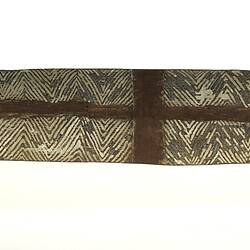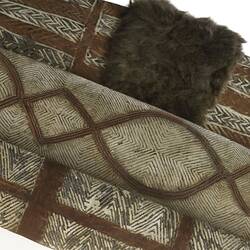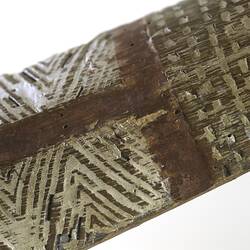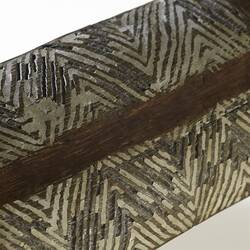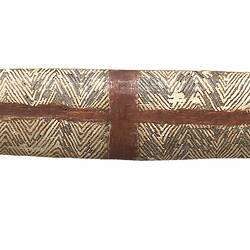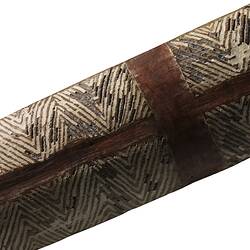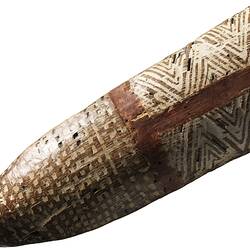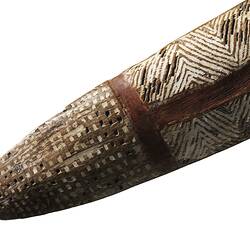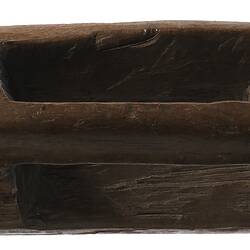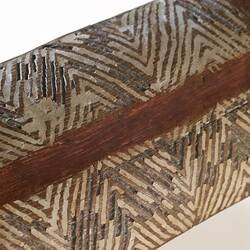Summary
Mulga are narrow, wedge-shaped shields that were typical among many of the Victorian and South-eastern Aboriginal groups pre-contact and during early colonial times. Used during close combat, they were effective defensive weapons against clubs and other hand-held weapons. They were often made of a solid but light wood obtained from the inner timber of a tree, which was then shaped using stone tools or mussel shells.
The maker of this mulga has created a design of incised zigzag lines, and on each end a pattern of repeated broken lines. These incisions have all been filled with white pipeclay. Five horizontal bands and one running the length of the shield down the centre have been painted with red ochre. The design is visually arresting, and a dextrous warrior would use this in part to create a distracting optical illusion in battle.
Intricate designs in wood characterise the visual culture of south-eastern Australian Aboriginal people in the 19th century. The designs on all types of shields were infinitely variable, and no two are exactly the same. These designs are also used on tree carvings, possum-skin cloaks, and wooden implements and painted on the bodies of dancers. Like other art forms in the south-east the meaning of the designs is thought to relate to individual and group identity. Shields were also viewed as having innate power, and an old shield that had 'won many fights' was prized as an object of trade
Local Name
Mulga
Physical Description
Narrow and deep carved wooden mulga (shield) which has a roughly diamond-shaped profile. It has a handle carved into it, and has incised and painted decoration on its front surface. The decoration is in the form of a wide grid filled with narrowly spaced parallel diagonal lines, and rows of small squares at either end. The grid is painted with red ochre and the lines and squares are filled with white ochre.
Significance
The history of 'ownership' of such objects between leaving the possession of Aboriginal people and becoming part of Museum Victoria collections is diverse and often obscure. Early collectors acquired objects such as these because it was ignorantly believed that Aboriginal people were 'a dying race'. This false belief and the growing interest in ethnography created a very active trade in First Peoples objects from the mid-nineteenth century onwards. As with this mulga, it was common for collectors and institutions to be ignorant of the diversity and specificity of the culture of the First Peoples of Australia and therefore makers, their language group and homelands were often not recorded. However, items can be partially identified by common artistic styles belonging to specific areas of Australia.
Museum and gallery collections of Aboriginal and Torres Strait material culture are being used by artists and community to research, reclaim and celebrate expressions of culture that have been handed down over hundreds of generations.
Gunnai/Kurnai artist Ray Thomas speaks of the inspiration he felt on studying his people's shields in the Museums Victoria collection;
'They were absolutely stunning designs you know, the lineal work - fine etched line work into the wood. That day when I was in the museum with these shields, well that just completely changed my thinking about my art and myself as an artist and from that day on I never painted dots again and the cross-hatching style because I found something that was mine. Part of my culture, my identity and who I am and from my area. So I began to incorporate traditional designs and markings into my work.' Ray Thomas 2010
References
Keeler, C. and Couzens, V., (eds) 2010, Meerreeng-An, Here is my Country: The Story of Aboriginal Victoria Told Through Art, p. 162, Koorie Heritage Trust/BPA Print Group.
More Information
-
Object/Medium
Shield
-
Maker
-
Locality
-
Date Produced
-
Object Measurements
720 mm (Length), 80 mm (Width), 80 mm (Height)
-
Classification
-
Date Made
-
Maker
-
Clan/Language Group
-
Place Made
-
Indigenous Region
-
Keywords
-
Acquisition Information
Purchase from (Estate of) Henry A. Smith, Mr H F. Richardson, 07 May 1888
-
Collection Names
-
Type of item
-
Discipline
-
Category
-
Collecting Areas

